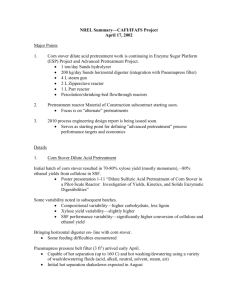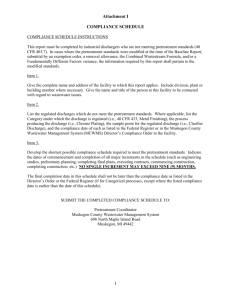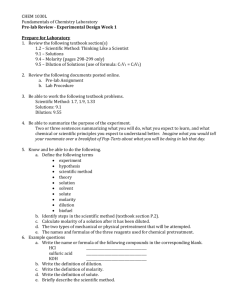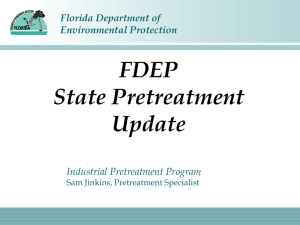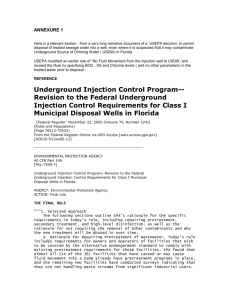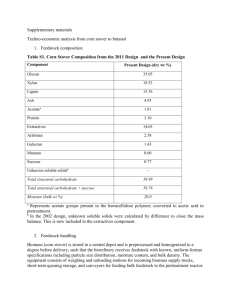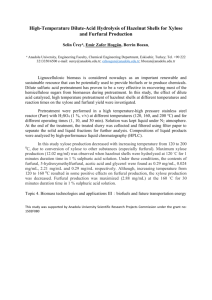Manuscript
advertisement
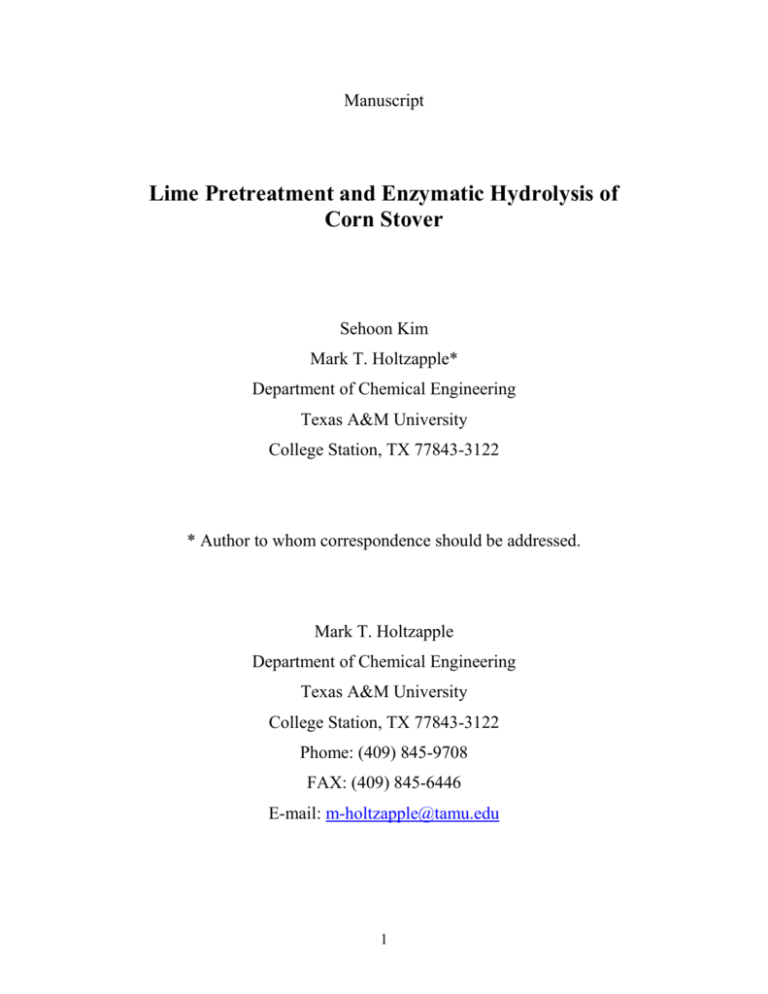
Manuscript
Lime Pretreatment and Enzymatic Hydrolysis of
Corn Stover
Sehoon Kim
Mark T. Holtzapple*
Department of Chemical Engineering
Texas A&M University
College Station, TX 77843-3122
* Author to whom correspondence should be addressed.
Mark T. Holtzapple
Department of Chemical Engineering
Texas A&M University
College Station, TX 77843-3122
Phome: (409) 845-9708
FAX: (409) 845-6446
E-mail: m-holtzapple@tamu.edu
1
Abstract
Corn stover was pretreated with an excess of calcium hydroxide (0.5 g Ca(OH)2/g
raw biomass) in non-oxidative and oxidative conditions at 25, 35, 45, and 55oC. The
optimal condition is 55 oC for 4 weeks with aeration. Glucan (91.3%) and xylan (51.8%)
were converted to glucose and xylose respectively, when the treated corn stover was
enzymatically hydrolyzed with 15 FPU/g cellulose. Only 0.073 g Ca(OH)2 was consumed
per g of raw corn stover. Of the initial lignin, 87.5% was maximally removed. Almost all
acetyl groups were removed.
After 4 weeks at 55oC with aeration, some cellulose and hemicellulose were
solubilized as monomers and oligomers in the pretreatment liquor. When considering the
dissolved fragments of glucan and xylan in the pretreatment liquor, the overall yields of
glucose and xylose were 93.2% and 79.5% at 15 FPU/g cellulose. The pretreatment
liquor has no inhibitory effect on ethanol fermentation.
Introduction
In previous studies on lime pretreatment, the pretreatment conditions were
optimized for different types of lignocellulosic materials on the basis of 3-d enzyme
digestibility: bagasse, 120oC, 1 h (Chang et al. 1998); switchgrass, 100 – 120oC, 2 h
(Chang et al. 1997); corn stover, 120oC, 4 h (Kaar et al. 2000); poplar wood, 150oC, 6 h,
14 bar absolute oxygen (Chang et al. 2001); newspaper, 140oC, 3 h, 7.1 bar absolute
oxygen (Chang et al. 2001). Most cases were optimized at high temperatures (100 –
150oC) and pure oxygen was used for oxidative treatments. Klinke et al. (2002) reported
that cellulose in wheat straw is efficiently recovered in the solid fraction (96%) and
enzymatically converted to glucose in high yield (67%) in alkaline wet oxidation
2
pretreatment, e.g., 195oC, 10 min, 12 bar oxygen and 6.5 g/L of Na2CO3. Most cases
were optimized at high temperature ranges (100 – 200oC) and pure oxygen was used to
meet the oxidative treatment. However, the specially designed vessel (e.g., stainless steel
tank that resists high pressure and corrosion) and the large amounts of pure oxygen are
not economical for low-cost biomass pretreatments at commercial scale.
From this view, in this study, pretreatment conditions were reconsidered and
optimized in moderate temperature ranges (25 – 55oC) with air instead of pure oxygen.
The efficiency of enzymatic hydrolysis was evaluated to determine the optimal
conditions for the corn stover treated in this new method.
Carbohydrates in the presence of alkali and oxygen undergo both oxidation and
alkaline degradation to produce a complex mixture of products (Montgomery 1953,
Williams et al. 1982, McGinnis et al. 1984, and Klinke et al. 2002). Hydroxy-carboxylic
acids, such as glucoisosaccharinic and xylosaccharinuc acids, are formed from the
degradation of cellulose and hemicellulose. The peeling reaction (or endwise
depolymerization reaction) is a β-elimination that begins at the reducing end of the
molecule and proceeds along the chain liberating saccharinate molecules (Lai 2001). The
formation of low-molecular-mass fragments, such as glycolic and lactic acids, increases
at more severe reaction conditions, i.e., high alkaline concentration or high-temperature
conditions (Sjöström 1991). Cellulose is relatively more stable to alkaline wet oxidation
than xylan.
The amounts of cellulose and hemicellulose that are dissolved and degraded in the
liquid fraction of lime-treated corn stover were determined to build a complete mass
balance. Those portions of mono- or oligo-saccharides in the liquid fraction can be
3
treated as another carbon source for alcohol fermentation. To determine whether the
pretreatment liquor is fermentable or not, the fermentability was tested for the
pretreatment liquor by cultivating Saccharomyces cerevisiae D5A in YPD medium.
The potential ethanol production was estimated for corn stover pretreated at the
optimal lime treatment condition and enzymatically hydrolyzed at 15 and 60 FPU/g
cellulose.
Materials and Methods
Lime pretreatment
Corn stover was supplied from NREL (National Renewable Energy Laboratory,
Golden, CO) in two different batches (Source: BioMass AgriProducts, Harlan, IA). The
stover was already washed, dried, and milled to pass ¼-inch round screen before being
delivered to our laboratory.
Corn stover was pretreated with lime (calcium hydroxide) in the presence of water.
Packed-bed PVC columns (D L = 1 inch 17 inches) were used for the limepretreatment reaction at 25 (ambient temperature), 35, 45, and 55 oC. Nitrogen and air
were purged into each reactor to make non-oxidative and oxidative conditions,
respectively, after being preheated and saturated in the immersed cylinder in the heating
tank. Air was scrubbed of carbon dioxide by passing it through a lime-water slurry in a
bottle. A schematic diagram of the whole reactor system is shown in Figure 1.
Compositional analyses
The contents of cellulose and hemicellulose in untreated and treated corn stovers
were analyzed by HPLC using Aminex HPX-87P column (Bio-Rad, U.S.A.) and
refractive index (RI) detector (RefractoMonitor® III, Model 1109, LDC/MiltonRoy,
4
U.S.A), as described in NREL standard procedure No. 2CS (Determination of structural
carbohydrate content in corn stover feedstocks by HPLC). Protein (or total nitrogen)
content was estimated using LECO CHN-600 Determinator (Soil, Water and Forage
Testing Laboratory, Texas A&M University, TX). Lignin (Klason and acid-soluble)
contents and acetyl group content were determined as described in NREL standard
procedures No. 03 and No. 04, respectively. Ash content was determined as the amount
of inorganic residue left after ignition at 575 15oC (NREL Standard Method No. 05).
The acetyl content was determined for the untreated and treated corn stovers by
the modified method from Whistler and Jeans (1943). The methyl acetate was
quantitatively distilled and saponified in standard alkali (Browning 1967). Dry corn
stover (0.5 g) was transesterified to convert acetyl groups to methyl acetate using 120 mL
of anhydrous methanol and 20 mL of 0.2-N sodium methoxide in the round-bottom flask
at 80oC. The volatile ester was distilled and then 25 mL of 0.1-N sodium hydroxide was
added into the distillation flask. After saponification of the distilled sample at 100 oC for
20 min, the amount of methyl acetate was determined by titration with 0.1-N HCl.
Sugar analysis in pretreatment liquor
The pretreatment liquors were collected from the corn stover slurry by filtration,
which was treated with lime and air at 55oC for 4 and 8 weeks and then neutralized with
hydrochloric acid.
Monosaccharides (glucose, xylose, and arabinose) and disaccharides (cellobiose
and xylobiose) in the liquor were analyzed by an HPLC using HPX-87C and -87P
columns and the RI detector, as described in NREL standard procedure No. 13. The total
sugars (from monomer to oligomer) and other organic degradation products (e.g., acetic
5
acid, lactic acid, HMF, and furfural) were analyzed by HPLC using HPX-87H column
and the refractive index detector, as described in NREL standard procedures No. 14 and
No. 15.
Enzyme hydrolysis
Substrates for the enzyme reaction were the untreated washed-only (control), the
non-oxidatively lime-treated, and the oxidatively lime-treated corn stovers. The substrate
concentration was 10 g cellulose/L. Cellulase enzyme (Spezyme CP, Lot 301-00348-257)
was kindly provided by NREL. Excess amounts of -glucosidase (Novozyme 188, 250
CBU/g of activity) were added to completely convert cellobiose to glucose, i.e., 40
CBU/g cellulose. Cellulase was added at the following specific loading rates: 0, 2, 10, 20,
40, and 120 FPU/g cellulose. Cellulase activity was periodically determined as filter
paper units per mL, as described by NREL standard procedure No. 06. Citrate buffer (1.0
M, pH 4.8) and sodium azide solution (1 (w/w)%) were used to keep constant pH and
prevent microbial contamination, respectively.
The concentration of sugars (glucose and xylose) was determined by the DNS
method (Miller 1959) and the HPLC method using Aminex HPX-87P column (BioRad,
U.S.A.) and RI detector. The reducing sugar concentration determined by the DNS
method was reported as equivalent glucose.
Fermentability of lime pretreatment liquor
To characterize the relative fermentability of pretreatment liquors, glucose
fermentations were performed using a control sample and various dilutions of
hydrolyzates.
6
Saccharomyces cerevisiae D5A was cultivated in a 125-mL serum bottle with seals
containing YPD (10 g/L yeast extract, 20 g/L peptone, and 20 g/L glucose) medium with
or without pretreatment liquor at 38oC and 130 rpm. Pretreatment liquor (25 mL) was
added into 22 mL of YP medium (10YP medium 5 mL, 1.0-M citrate buffer 2.5 mL,
and deionized water 14.5 mL) and the mixture was sterilized at 121oC for 30 min. One
mL of inoculum cultured for 24 hours was added, after 2 mL of 50% glucose solution
was added into autoclaved YP medium. The fermentability of the pretreatment liquor was
characterized by the following equations:
Relative rate =
[Ethanol] at 24 h, test / [Glucose] at 0 h, test
× 100 (%)
[Ethanol] at 24 h, control / [Glucose] at 0 h, control
[Ethanol] at 72 h, test / [Glucose] at 0 h, test
Relative yield =
× 100 (%)
[Ethanol] at 72 h, control / [Glucose] at 0 h, control
(1)
(2)
The control fermentation was performed at each run with the test fermentations and
the results served as the denominator in Equations 1 and 2 for each experiment. Yeast cell
concentration was reported as optical density (O.D.) measured at 600 nm by a
spectrophotometer with a 1-cm path length. Ethanol concentration was determined by gas
chromatography (6890 Series, Agilent Technologies, U.S.A.) using an analytical column
HP-5 (dimension: 30 m × 0.32 mm × 0.25 μm, Agilent Technologies, U.S.A.) at the
following operating conditions: 40oC, oven temperature; 230oC, inlet temperature; 240oC,
detector temperature; 40 mL/min, H2 flow; 179 mL/min, He flow; 400 mL/min, air flow;
12.75 min, run time.
7
Definitions of yields for glucose and xylose
The final concentration of glucose and xylose depend on the yields in two steps:
pretreatment and enzymatic hydrolysis. Yields for each step were defined as follows:
(1) Pretreatment yields
Glucan yield (YG) =
g glucan in treated biomass
g glucan in raw biomass
(3)
Xylan yield (YX) =
g xylan in treated biomass
g xylan in raw biomass
(4)
(2) Hydrolysis yields
Glucan yield (Yg) =
g glucan hydrolyzed
g glucose
162.2
=
g glucan in treated biomass
g glucan
180.2
(5)
Xylan yield (Yx) =
g xylan hydrolyzed
g xylan in treated biomass
(6)
=
g xylose
132.1
g xylan
150.1
(3) Overall yields
Glucan yield (YgT) = YG Yg =
Xylan yield (YxT) = YX Yx =
g glucan hydrolyzed
g glucan in raw biomass
g xylan hydrolyzed
g xylan in raw biomass
(7)
(8)
Results and Discussions
Lime consumption
During non-oxidative lime treatment, the maximum specific lime consumption was
0.058 g Ca(OH)2/g raw biomass at 55oC. The specific lime consumption tended to
increase, as temperature increased (Figure 2 (a)).
8
For oxidative lime pretreatment, lime consumption significantly increased as
temperature increased (Figure 2 (b)). The specific lime consumption (g Ca(OH)2/g raw
biomass) was 0.047 at 4 weeks and 0.097 at 16 weeks at 25oC, and 0.073 at 4 weeks and
0.176 at 16 weeks at 55oC.
Compositional changes in corn stover due to lime pretreatment
In most cases, during the first 2 weeks, there was a rapid decrease of total solids
caused mostly by delignification. After 2 weeks, the loss of solids was not significant in
the non-oxidative pretreatment with lime (Figure 3 (a)). In the oxidative lime
pretreatment, the solid weight loss became more significant after 1 week due to additional
delignification (Figure 3 (b)).
The degradation of holocellulose, especially xylan, occurred more severely after 4and 8-week pretreatments at 55 and 45oC, respectively. However, the glucan fraction was
relatively more stable than xylan. For instance, after 16 weeks at 55oC, 93.7% of glucan
and 79.3% of xylan remained in the non-oxidatively treated corn stover, whereas 71.0%
of glucan and only 50.3% of xylan was recovered in the oxidatively treated corn stover.
At 55oC in oxidative conditions, almost all glucan and more than 67% of xylan was
recovered at 4 weeks, but the degradations of glucan and xylan was significant after 8
weeks (Figure 4).
The non-oxidative condition has a higher recovery of glucan and xylan than the
oxidative condition; however, more than 50% of the lignin still remained in the pretreated
corn stover after the non-oxidative treatment, which negatively affects the enzymatic
hydrolysis.
9
Delignification
During non-oxidative lime pretreatment, the acid-soluble lignin in the pretreated
corn stover decreased from 1.8% to 1.2%. However, in the case of oxidative pretreatment,
acid-soluble lignin in the pretreated corn stover started to decrease for the first 2 weeks,
but gradually recovered after 2 weeks, even though the increase was relatively small
compared with Klason lignin (data not shown).
During non-oxidative lime pretreatment, removal of Klason lignin occurred
significantly within the first 2 weeks of treatment, but did not depend on temperature
after around 4 weeks (Figure 5 (a)).
On the other hand, during oxidative pretreatment, Klason lignin decreased
significantly throughout the entire treatment time. Delignification depended on
temperature (Figure 5 (b)). For 16 weeks in oxidative lime pretreatment, the Klason
lignin content decreased to 10.5 and 4.3% at 25 and 55 oC, respectively.
During the 16-week lime pretreatment, non-oxidative delignification removed up to
43.6, 46.3, 48.4, and 47.7% of the initial lignin at 25, 35, 45, and 55oC, respectively.
However, oxidative delignification removed up to 57.8, 66.2, 80.9, and 87.5% of the
initial lignin at 25, 35, 45, and 55oC, respectively during the same period.
Deacetylation
The acetyl content was 2.2 and 3.2% in the first and second batch of raw corn
stover, respectively.
Deacetylation is a relatively quick reaction; nearly complete deacetylation occurred
within 4 weeks for all cases of lime pretreatment.
10
There is no significant influence of temperature. Deacetylation at higher
temperatures (100oC) was similar to that at lower temperatures (25 – 55oC). For instance,
97.1 0.3 % of acetyl groups in raw corn stover was removed when the corn stover was
pretreated with lime (0.1 g Ca(OH)2/g raw biomass) at 100oC for 2 h, a common limetreatment condition. Therefore, deacetylation in corn stover occurs mainly from lime
pretreatment and does not require oxygen. For the first batch of corn stover, oxidative
lime pretreatment gives a little higher (+7%) deacetylation than non-oxidative lime
treatment (Table 1). There is no significant influence on deacetylation between the two
different batches of corn stover.
When corn stover was treated hydrothermally without lime at 55oC for 10 weeks,
deacetylation occurred up to 46.5 and 49.2% in non-oxidative and oxidative conditions,
respectively. Furthermore, acetyl groups were removed up to 13.9% when corn stover
was incubated with only water at room temperature for 10 weeks (Table 2). Thus, some
deacetylation can occur by autohydrolysis reactions in mild hydrothermal treatment
without lime; further, it is not affected by the presence of oxygen. The acetyl group was
removed very quickly regardless of temperature and the oxidation condition, whereas
lignin was removed gradually throughout the pretreatment and depended on the
pretreatment condition. For example, deacetylation reached a plateau within 1 week and
there were no significant differences between non-oxidative conditions at 25oC and
oxidative conditions at 55oC. However, the delignifications at these two conditions were
very different.
11
Hydrolysis yields of cellulose/hemicellulose to glucose/xylose
The enzymatic digestibility of corn stover increased dramatically due to lime
pretreatment. It also depended on temperature, time, and the presence of oxygen.
During the 16-week non-oxidative lime pretreatment, the 3-d enzyme digestibility
(mg equiv. glucose/g raw biomass) was 3-fold higher than untreated corn stover over the
entire range of cellulase concentrations (Figure 6). Without air, the 3-d sugar yield at
55oC was only 9.0 1.6% higher than at 25oC. For non-oxidative lime pretreatment, the
temperature effect on the enzymatic digestibility of corn stover was not very significant.
The enzymatic digestibility of corn stover can be significantly improved by
oxidative lime pretreatment. Aeration was more effective on 3-d enzyme digestibility at
higher temperature, 55oC (Figure 7).
With 25oC non-oxidative lime pretreatment, when the enzyme loading was 15
FPU/g cellulose, the hydrolysis yield for glucose (Yg; g glucan hydrolyzed/g glucan in
treated biomass) rapidly increased from 0.26 to 0.55 within 2 weeks and slightly
increased up to 0.64 for the remaining pretreatment. With aeration at the same condition,
the profile of Yg was not significantly different from the result of no aeration.
However, at higher temperatures (i.e., 55oC), the Yg profiles with and without
aeration were significantly different. Yg in the non-oxidative pretreatment reached a
maximum (0.77) after 8 weeks, whereas the oxidative pretreatment achieved more than
0.93 after 4 weeks (Figure 8 (a)).
On the other hand, when the enzyme loading was 15 FPU/g cellulose, the
hydrolysis yield for xylose (Yx) rapidly increased within a few weeks in the same manner
12
as Yg, but the maximal values were respectively 0.76 and 0.72 for the non-oxidative and
oxidative pretreatment at 55oC for 4 weeks (Figure 8 (b)).
Interestingly, the ratio of glucose to xylose (G/X) that was enzymatically
hydrolyzed increased with respect to pretreatment time, temperature, and oxidation
condition (Figure 9). G/X increased from 1.83 at 0 week (‘untreated’) to 2.31 and 2.92 in
the non-oxidative and oxidative pretreatment at 25oC for 16 weeks, respectively. G/X in
non-oxidative lime pretreatment showed a relatively constant value compared with the
ratio obtained from the oxidative treatment after 4 weeks. In the oxidative lime
pretreatment, G/X increased as temperature increased, because more xylan was removed
due to extensive delignification. At higher temperatures in the oxidative lime preteatment,
cellulose is much more enzymatically digestible than hemicellulose as pretreatment time
elapsed.
The corn stover pretreated at optimal conditions hydrolyzed quickly. Compared
with the hydrolysis rate of α-cellulose (SIGMA catalog no. C-8002), the relative
digestibility of pretreated corn stover reached a maximum in a short hydrolysis time
(Figure 10). For a given biomass, the relative digestibility is defined as the ratio of the
digestibility at a particular time to its digestibility at 96 h, which is assumed to be the
asymptotic maximum (ultimate digestibility).
The digestibility (hydrolysis yield) at 96 h of hydrolysis was 0.88 and 0.99 (g
glucan digested/g glucan in substrate) for α-cellulose, and 0.98 and 0.99 for pretreated
corn stover at 15 and 60 FPU/g cellulose, respectively. To obtain 90% of the relative
digestibility, α-cellulose needs to be enzymatically hydrolyzed over 47 h and 43 h,
whereas the pretreated corn stover requires just 15 h and 9 h, at 15 and 60 FPU/g
13
cellulose, respectively. Apparently, in enzyme hydrolysis, xylan in the corn stover
requires more time to be completely hydrolyzed than glucan (Figure 10).
Overall yields of glucose and xylose
To evaluate the optimal condition for the lime pretreatment of corn stover, overall
yields of glucose (YgT) and xylose (YxT) must be considered. The final concentrations of
mono-sugars (glucose and xylose) depend on the pretreatment yield of cellulose (YG) and
hemicellulose (YX) in the lime pretreatment and also the hydrolysis yield of glucose (Yg)
and xylose (Yx) in the saccharification.
The overall yield of cellulose (YgT) increased rapidly during the first 2 weeks and
gradually in the remaining period of lime pretreatment and was not significantly different
between the non-oxidative and oxidative conditions below 45oC (Table 3).
However, at 55oC for 4 weeks at 15 FPU/g cellulose, YgT increased up to 0.75 and
0.91 g glucan hydrolyzed/g glucan in raw biomass in non-oxidative and oxidative
pretreatments, respectively. At 55oC after 4 weeks, YgT tended to decrease in both
pretreatments (Figure 11 (a)).
The overall yield of hemicellulose (YxT) was slightly higher in the non-oxidative
pretreatment than in the oxidative pretreatment. YxT was maximized around 4 weeks at
55oC in both non-oxidative and oxidative conditions (Figure 11 (b)).
For 15 FPU/g cellulose of enzyme loading, the maximal values of YgT and YxT are
summarized for each pretreatment condition (Table 3).
When the enzyme loading was increased to 60 FPU/g cellulose, YgT and YxT at the
optimal condition (55oC, 4 week, and aeration) were enhanced to 0.96 and 0.54,
respectively. At lower enzyme loadings, i.e., 2.1 FPU/g cellulose, YgT and YxT are 0.69
14
and 0.39, respectively. At the optimal condition (4 weeks, 55oC, and aeration) for lime
pretreatment, the profiles of YgT and YxT are compared with respect to the different
enzyme loadings from 2.1 to 60 FPU/g cellulose (Figure 12).
Cellulose was almost completely digested, but hemicellulose was not. This might
result from a low hemicelluase activity in the enzyme preparation, which was optimized
for cellulase activity. For example, using Spezyme CP (cellulase) at 5 FPU/g xylan and 5
FPU/g cellulose, 59.0% of the initial xylan (Sigma Catalog No. X-0502, U.S.A.) was
hydrolyzed whereas 81.3% of the initial α-cellulose (Sigma Catalog No. C-8002, U.S.A.)
was digested during the 96-h enzyme hydrolysis (Figure 13).
Mass balance from raw corn stover to enzyme hydrolysis
In this study of the lime pretreatment, cellulose was recovered in high yield,
whereas hemicellulose was not. In other words, most of the cellulose remained in the
solid fraction, whereas hemicellulose was relatively labile and dissolved in the liquid
fraction in lime pretreatment at mild conditions (25 55oC).
At 55oC with aeration, cellulose was not significantly degraded at 4 weeks.
However, after 8 weeks in this condition, 14.5% of cellulose was dissolved into the
pretreatment liquor. Most of the cellulose fragments (89.8%) were degraded and only
10.2% of the cellulose fragments existed as intact glucooligomers (degree of
polymerization ≥ 2) (Table 4).
However, there were no furan intermediates degraded from glucose because 5hydroxymethylfurfural (HMF) peaks (retention time 14.7 min) were not detected in the
pretreatment liquor. Therefore, the cellulose backbone was broken between 4 and 8
15
weeks at 55oC with air in lime pretreatment and then degraded into small molecules, such
as acetic acid and carbon dioxide.
Hemicellulose was mainly recovered in the solid fraction, but more than 32% was
dissolved in the liquid fraction after pretreating for 4 weeks at 55oC using oxidative
conditions (Table 4). However, 2/3 of the dissolved hemicellulose existed as
xylooligomer, and was not degraded into small molecules. Hemicellulose degradation is
relatively slow compared to cellulose degradation. The 2-furfural peak (47.35 min of
retention time) was detected as an intermediate product of hemicellulose degradation.
Hemicellulose solubilization in lime pretreatment is closely related with
deacetylation and delignification. The residual fraction of hemicellulose in the solid
linearly depended on the residual fraction of lignin in the solid. The removal of acetyl
groups from hemicellulose occurred at the very beginning of lime pretreatment.
Interestingly, cellulose was much more stable than hemicellulose, but once cellulose
dissolved in the pretreatment liquid, it degraded faster than hemicellulose.
Total mass was well conserved through the whole process, e.g., mass balance
closure was 99.6% and 102.4% at 15 and 60 FPU/g cellulose, respectively, in the optimal
pretreatment (Table 5). Each component of raw corn stover was fractionated into the
solid and liquid fractions after lime pretreatment for 4 and 8 weeks at 55oC with aeration
(Tables 5 and 6).
Estimation of ethanol production
The ethanol yield from sugars (glucose and xylose) was assumed as 0.45 g
ethanol/g sugar in alcohol fermentation. It was assumed that 100 lb of dry raw corn stover
16
(second batch) was pretreated at the optimal condition (55oC, 4 weeks, and aeration) and
enzymatically hydrolyzed with 15 and 60 FPU/g cellulose for 3 days.
On the basis of these assumptions, the amount of ethanol (gallon) in yeast
fermentation was estimated by the case studies as follows:
Case 1. Fermentation of enzyme hydrolyzate saccharified from only solid fraction of
pretreatment:
This case considers glucose and xylose in the enzyme hydrolyzate obtained only
from the solid fraction of the pretreated corn stover. Per 100 lb of raw corn stover, 36.6 lb
of glucose (33 lb glucan 0.9) and 12.6 lb of xylose (11.1 lb xylan 0.88) can serve as
carbon sources for yeast fermentation, when the pretreated solid (35.3 lb glucan and 14.5
lb xylan) is hydrolyzed at 15 FPU/g cellulose of enzyme loading. It gives 3.38 gallons of
ethanol. If the same calculation is applied for 60 FPU/g cellulose, then 3.52 gallons of
ethanol can be produced.
Case 2. Fermentation of enzyme hydrolyzate plus the pretreament liquor:
This case considers the total sugars (glucose and xylose) generated in the
pretreatment step as carbon source for fermentation. The 0.63 lb of glucose and 5.91 lb of
xylose in the pretreatment liquor (PL) were added with the 36.6 lb of glucose and 12.6 lb
of xylose obtained from the enzyme hydrolysis at 15 FPU/ g cellulose in Case 1. It gives
3.88 gallons of ethanol. For 60 FPU/g cellulose, 4.02 gallons of ethanol can be produced.
Thus, an additional 0.50 gallons of the ethanol can be produced if the monomers and
sugar oligomers in the pretreatment liquor are used.
17
Fermentability of the pretreatment liquor
In YPD basal medium (10 g/L yeast extract, 20 g/L peptone, and 20 g/L glucose),
the optical density (O.D. measured at 600 nm with a standard cuvet (1-cm pathlength)) of
Saccharomyces cerevisiae D5A reached up to 6.5 0.2 at 24 h. In this fermentation, 21
g/L of initial glucose was completely consumed and the ethanol concentration was 11.3
1.2 g/L. After 24 h, the cell growth reduced and the ethanol concentration reduced to 9.9
1.0 g/L.
When 50% (v/v) of pretreatment liquor collected from the optimal pretreatment (4
weeks, 55oC, and aeration) was contained in the basal medium, the relative rate of
fermentation (Equation 1) was 86.1%, but the cell yield from glucose (Yc/g) was 17.9%
higher than that of the control during the 24-h cultivation. The relative ethanol yield of
the test medium (Equation 2) was 10.3% higher than that of the control, and Yc/g was still
higher after 72 h (Table 7).
In this study, there was no reduction in cell yield or ethanol yield from glucose for
the oxidative pretreatment liquors of corn stover. As the pretreatment time increased from
4 to 16 weeks, the relative rate of fermentation at 24 h was slightly lower. However, the
relative yield of ethanol fermentation at 72 h showed higher values in the pretreatment
liquor than in the control fermentation. Therefore, we conclud that there are no inhibitory
substances in pretreatment liquors against yeast cell growth and ethanol production.
Applications
Industrially, one possible implementation of the lime pretreatment technology is a
biomass pile that accomplishes both pretreatment and fermentation (Figure 14). Once the
biomass pile is pretreated with lime (0.073 g Ca(OH)2/g raw biomass) or quick lime
18
(0.058 g CaO/g raw biomass) at the optimal condition (55oC, 4 weeks, and aeration), the
fermentation can be performed in the same pile by direct inoculation and cultivation of
acid-forming microorganisms from ruminal or marine sources. The advantage of calcium
oxide (quick lime) is the release of heat when water reacts with calcium oxide, thus
allowing the pretreatment to occur at an elevated temperature.
During the lime pretreatment of the biomass pile, water should be circulated
through the pile by drawing water from the bottom and pumping it to the top, and air can
be blown upward through the pile to enhance lignin removal by alkaline oxidation. The
temperature of the pile can be controlled by regulating the temperature of the circulating
water using a heat exchanger.
Conclusion
The specific lime consumption (g Ca(OH)2/g raw biomass) tended to increase, as
temperature increased. More lime was consumed in oxidative conditions than in nonoxidative conditions because oxygen increased delignification.
Lime is a very effective chemical for deacetylation. In the presence of lime,
deacetylation is not significantly affected by temperature and the presence of oxygen. In
the absence of lime, however, deacetylation is influenced by temperature but not affected
by oxygen. Acetyl groups were removed very quickly regardless of temperature and the
oxidation condition for lime pretreatment, whereas lignin was removed gradually through
the whole period of pretreatment and depended on the pretreatment conditions.
More holocellulose (glucan and xylan) can be recovered in the non-oxidative lime
pretreatment of corn stover; however, the lignin cannot be removed significantly
compared to the oxidative lime treatment.
19
The enzymatic digestibility of corn stover increased dramatically due to lime
pretreatment and improved even further by oxidative lime pretreatment. Aeration was
more effective on 3-d enzymatic digestibility at higher temperature (55oC). G/X increased
as temperature increased, because more xylan was solubilized during the more extensive
delignification.
The highest overall conversion of holocellulose (cellulose and hemicellulose) to
mono-sugars (glucose and xylose) can be achieved when corn stover is treated with lime
at 55oC for 4 weeks in oxidative conditions, which is the recommended treatment
condition.
The solubilization of hemicellulose during lime pretreatment is closely related with
delignification. Cellulose was much more stable than hemicellulose, but cellulose
degraded faster, once it dissolved in the pretreatment liquid.
Using the optimal pretreatment, the overall yields of glucose (g glucan
hydrolyzed/100 g glucan in raw biomass) and xylose (g xylan hydrolyzed/100 g xylan in
raw biomass) were 91.3 and 51.8 at 15 FPU/g cellulose, and 95.5 and 53.5 at 60 FPU/g
cellulose, respectively.
Furthermore, when considering the dissolved fragments
(monomers and oligomers) of glucan and xylan in the pretreatment liquor, the overall
yields of glucose and xylose were 93.2 and 79.5 at 15 FPU/g cellulose, and 97.2 and 80.9
at 60 FPU/g cellulose, respectively.
When compared to the enzyme hydrolysis rate of α-cellulose, pretreated corn stover
reacted more quickly.
It is expected that 3.4 – 4.0 gallons of ethanol can be produced from 100 lb of raw
corn stover by the optimal lime pretreatment (4 weeks, 55oC, and aeration), enzyme
20
hydrolysis (15 – 60 FPU/g cellulose), and yeast fermentation. There are no inhibitory
substances in the pretreatment liquor that affect yeast cell growth and ethanol production.
Acknowledgement
This work was supported by the U.S. Department of Agriculture, contract number
00-52104-9663.
References
Browning, B.L. (1967). The isolation and determination of acetyl and methoxyl groups.
In: Methods of Wood Chemistry, vol. 2, pp. 655-657, Interscience, New York.
Chang, V.S., Burr, B. and Holtzapple, M.T. (1997). Lime pretreatment of switchgrass,
Applied Biochemistry and Biotechnology 63-65:3-19.
Chang, V.S., Nagwani, M. and Holtzapple, M.T. (1998). Lime pretreatment of crop
residues bagasse and wheat straw. Applied Biochemistry and Biotechnology 74:135159.
Chang, V.S. and Holtzapple, M.T. (2000). Fundamental factors affecting biomass
enzymatic reactivity. Applied Biochemistry and Biotechnology 84-86: 5-37.
Chang, V.S., Nagwani, M., Kim, C.H., and Holtzapple, M.T. (2001) Oxidative lime
pretreatment of high-lignin biomass, Applied Biochemistry and Biotechnology 94:1-28.
Kaar, W.E. and Holtzapple, M.T. (2000) Using lime pretreatment to facilitate the enzyme
hydrolysis of corn stover. Biomass and Bioenergy, 00:1-11.
Klinke, H.L., Ahring, B.K., Schmidt, A.S., and Thomsen, A.B. (2002). Characterization
of degradation products from alkaline wet oxidation of wheat straw, Bioresource
Technology 82:15-26.
21
Lai, Y.Z. (2001). Chapter 10 Chemical degradation. In: Wood and Cellulose Chemistry.
Hon, D.N.-S., and Shiraishi, N. eds, pp. 443 – 512, Marcel Dekker, Inc., New
York·Basel.
McGinnis, G.D., Prince, S.E., Biermann, C.J., and Lowrimore, J.T. (1984). Wet oxidation
of model carbohydrate compounds, Carbohydrate Research 128:51-60.
Miller, M.M. (2001). Lime, U.S. Geological Survey Minerals Yearbook – 2001. pp. 45.1
– 45.8 (Source: http://minerals.usgs.gov/minerals/pubs).
Montgomery, R. (1953). Observation of alkaline degradation of sugars, Industrial and
Engineering Chemistry 45(5):1144-1147.
Sjöström, Eero (1991). Carbohydrate degradation products from alkaline treatment of
biomass, Biomass and Bioenergy 1(1):61-64.
Whistler, R.L. and Jeans, A. (1943). Quantitative estimation of acetyl in carbohydrate
acetates, Industrial and Engineering Chemistry 15(5):317-318.
Williams, A.G. and Morrison, I. M. (1982). Studies on the production of saccharinic
acids by the alkaline treatment of young grass and their effectiveness as substrates for
mixed rumen microorganisms in vitro, J. Sci. Food Agric. 33:21-29.
22
Table 1. The average levels of deacetylation (g acetyl groups removed/100 g acetyl
groups in raw biomass) for corn stover treated with lime
Lime treatment
Non-oxidative
Oxidative
condition
Batch number of
First batch
Second batch
First batch
Second batch
corn stover
Average
89.1 ± 3.5
93.8 ± 1.6
96.1 ± 1.6
98.0 ± 1.0
Deacetylation*
Coefficient of
3.9
1.7
1.6
1.0
variation (%)
* These values are obtained from the data after 4 weeks for each combination of lime
treatment condition (non-oxidative or oxidative) and batch types of corn stover (first or
second).
Error band (±) indicates 1 standard deviation.
23
Table 2. Comparison of deacetylation (g acetyl groups removed/100 g acetyl groups in
raw biomass) between lime-free and lime pretreatments at 10th and 8th week,
respectively.
Treatment condition
Temperature (oC)
Lime-free
Lime
Non-oxidative
Oxidative
25
55
25
55
13.9 ± 4.9
86.5 ± 3.7
46.7 ± 4.5
89.6 ± 2.0
14.5 ± 7.8
95.7 ± 1.7
49.2 ± 3.1
97.3 ± 0.4
Error band (±) indicates 1 standard deviation.
24
Table 3. The maximal overall yields of glucose (YgT, g glucan hydrolyzed/g glucan in
raw biomass) and xylose (YxT, g xylan hydrolyzed/g xylan in raw biomass)
for each pretreatment with lime, when the enzyme loading was 15 FPU/g
cellulose.
Pretreatment
Non-oxidative
Oxidative
Temperature
(oC)
YgT
YxT
YgT
YxT
25
0.67
(16)
0.53
(8)
0.70
(16)
0.46
(8)
35
0.64
(16)
0.52
(16)
0.70
(16)
0.43
(8)
45
0.73
(16)
0.56
(16)
0.77
(16)
0.39
(8)
0.54
(4)
0.91
(4)
0.51
(4)
0.75
(4)
( ): pretreatment time (weeks)
55
25
Table 4. The weight percentages of cellulose and hemicellulose degraded and
undegraded in the pretreatment liquor, and recovered in the solid stover
treated with lime at 55oC with aeration for 4 and 8 weeks.
Component
Fractions
Cellulose
Hemicellulose
4 week
8 week
4 week
8 week
Degraded
0.6
13.0
7.9
11.8
Undegraded
1.6
1.5
24.3
22.5
Solid
97.8
85.5
67.8
65.7
26
Table 5. Mass balances from raw corn stover to enzyme hydrolysis of the pretreated
corn stover at 55oC with aeration for 4 weeks.
Enzyme hydrolysis
In 100 lb of
raw biomass
Raw
Component
Solid
Solid
Liquid
Solid
Liquid
Solid
Liquid
Glucan
36.1
35.3
0.585)
2.39)
33.0
0.89)
34.5
Xylan
21.4
14.5
5.26)
3.49)
11.1
3.19)
11.4
Arabinan
3.6
1.4
2.2
1.4
0.0
1.4
0.0
K. Lignin1)
17.2
5.7
11.5
5.7
0.0
5.7
0.0
A. Lignin2)
3.6
3.6
0.0
3.6
0.0
3.6
0.0
Protein
3.5
1.3
2.2
1.3
0.0
1.3
0.0
Acetyl
3.2
0.2
3.17)
0.2
0.0
0.2
0.0
Ash
6.9
8.6
NM8)
6.9
0.0
6.9
0.0
Others3)
6.1
6.4
NM8)
7.6
0.0
9.8
0.0
101.6
77.0
24.8
32.410)
44.1
32.810)
45.9
Total (lb)
Lime pretreatment
15 FPU/g cellulose
60 FPU/g cellulose
for 15 PU/g cellulose
{(77.0+24.8)/101.6}×{(32.4+44.1)/77.0}×100 = 99.6%
for 60 FPU/g cellulose
{(77.0+24.8)/101.6}×{(32.8+45.9)/77.0}×100 = 102.4%
1) Klason lignin
2) Acid-soluble lignin
3) Others = mannan + galactan + uronic acid + non-structural sugars
4) [{Mass (PS)+Mass(PL)}/Mass(RC)]×[{Mass(ER)+Mass(EH)}/Mass(PS)]×100 (%)
5) Total glucan dissolved (lb) = (0.19 lb glucose + 0.44 lb glucooligomer) × 0.9 in the
pretreatment liquor
6) Total xylan dissolved (lb) = (0.19 lb xylose + 5.72 lb xylooligomer) × 0.88 in the
pretreatment liquor
7) The amounts of acetic acid in the pretreatment liquor measured by HPLC
8) NM = not measured
9) Undigested glucan or xylan in enzyme hydrolysis
10) Total amounts of the residual solid in enzyme hydrolysis measured gravimetrically
* It was assumed that the enzyme hydrolyzate contained glucose and xylose only. It is
expressed as equivalent glucan and xylan.
Mass
balance
closures4)
27
Table 6. Mass balances from raw corn stover to enzyme hydrolysis of the pretreated
corn stover at 55oC with aeration for 8 weeks.
Enzyme hydrolysis
In 100 lb of
raw biomass
Raw
Component
Solid
Solid
Liquid
Solid
Liquid
Solid
Liquid
Glucan
36.1
30.9
0.55)
1.29)
29.7
0.49)
30.5
Xylan
21.4
14.1
4.86)
4.19)
10.0
4.59)
9.6
Arabinan
3.6
1.7
1.9
1.7
0.0
1.7
0.0
K. Lignin1)
17.2
3.5
13.7
3.5
0.0
3.5
0.0
A. Lignin2)
3.6
3.6
0.0
3.6
0.0
3.6
0.0
Protein
3.5
1.1
2.4
1.1
0.0
1.1
0.0
Acetyl
3.2
0.1
2.87)
0.1
0.0
0.1
0.0
Ash
6.9
9.4
NM8)
9.4
0.0
9.4
0.0
Others3)
6.1
7.4
NM8)
7.3
0.0
8.3
0.0
101.6
71.8
26.1
32.010)
39.7
32.610)
40.1
Total (lb)
Lime pretreatment
15 FPU/g cellulose
60 FPU/g cellulose
for 15 PU/g cellulose
{(72.0+26.1)/101.6}×{(32.0+39.7)/71.8}×100 = 96.4%
for 60 FPU/g cellulose
{(72.0+26.1)/101.6}×{(32.6+40.1)/71.8}×100 = 97.8%
1) Klason lignin
2) Acid-soluble lignin
3) Others = mannan + galactan + uronic acid + non-structural sugars
4) [{Mass (PS)+Mass(PL)}/Mass(RC)]×[{Mass(ER)+Mass(EH)}/Mass(PS)]×100 (%)
5) Total glucan dissolved (lb) = (0.00 lb glucose + 0.59 lb glucooligomer) × 0.9 in the
pretreatment liquor
6) Total xylan dissolved (lb) = (0.00 lb xylose + 5.48 lb xylooligomer) × 0.88 in the
pretreatment liquor
7) The amounts of acetic acid in the pretreatment liquor measured by HPLC
8) NM = not measured
9) Undigested glucan or xylan in enzyme hydrolysis
10) Total amounts of the residual solid in enzyme hydrolysis measured gravimetrically
* It was assumed that the enzyme hydrolyzate contained glucose and xylose only. It is
expressed as equivalent glucan and xylan.
Mass
balance
closures4)
28
Table 7. Fermentability of the pretreatment liquors collected in the non-oxidative and
oxidative conditions at 55oC.
Oxidative
pretreatment
Non-oxidative
pretreatment
Parameters
Culture
Time
(h)
Control
Yc/g1)
24
72
Ye/g2)
Relative
rate3)
1
day*
16
week*
4
weeks*
8
weeks*
16
weeks*
0.12
0.11
0.12
0.10
0.09
0.09
0.14
0.15
0.17
0.16
0.12
0.12
24
72
0.44
0.35
0.45
0.43
0.62
0.51
0.40
0.41
0.57
0.55
0.55
0.59
24
100
107.3
85.6
86.1
99.9
87.8
Relative
72
100
112.4
94.4
110.3
115.3
108.4
yield4)
* Pretreatment time.
1) Cell yield for glucose = g cell increased/g glucose consumed (g cell = 0.414 × O.D.).
2) Ethanol yield for glucose = g ethanol produced/g glucose consumed.
3) Defined in Equation 1.
4) Defined in Equation 2.
29
R1
R2
R3
R4
R5
R6
R7
R8
R9
R10
Reactors
Water
Jacket
Manifold
(N2 or Air)
Manifold
(Water)
Frame
Tank
Temperature
Controller
Tray
Pump
Drain
Water
Temperature
sensor
Float
ATM
Heating Element
o
C
P
CO2
N2 scrubber
or
Air
Figure 1. Schematic diagram of the jacketed reactor system for lime pretreatment
in the non-oxidative (N2 supply) and oxidative (air supply) conditions.
30
Specific lime consumption
(g Ca(OH)2/g raw biomass)
0.10
25o C
35o C
45o C
55o C
0.08
0.06
0.04
0.02
0.00
0
2
4
6
8 10 12 14 16 18
Pretreatment time (weeks)
(a)
Specific lime consumption
(g Ca(OH)2/g raw biomass)
0.30
25o C
35o C
45o C
55o C
0.20
0.10
0.00
0
2 4 6 8 10 12 14 16 18
Pretreatment time (weeks)
(b)
Figure 2. Specific lime consumption as a function of pretreatment time in
non-oxidative conditions (a) and in oxidative conditions (b).
31
Corn stover components
(g/100 g raw biomass)
100
Solubilized
80
60
Holocellulose
40
20
Lignin
0
Ash
0
2
4
6
8
Protein
Others
10 12 14 16
Pretreatment time (weeks)
(a)
Corn stover components
(g/100 g raw biomass)
100
Solubilized
80
60
40
Holocellulose
Lignin
20
Protein
Others
Ash
0
0
2
4
6
8
10 12 14 16
Pretreatment time (weeks)
(b)
Figure 3. Mass profiles of total solid, holocellulose (glucan + xylan), lignin
(Klason lignin + acid-soluble lignin), crude protein, ash, and others
in lime-treated corn stover at 55oC in non-oxidative (a) and oxidative
(b) conditions.
32
Pretreatment yield of
cellulose, YG
g glucan recovered
100 g glucan in raw biomass
120
No air
100
80
Air
60
40
20
0
0
2
4
6
8 10 12 14 16 18
Pretreatment yield of
hemicellulose, YX
g xylan recovered
100 g xylan in raw biomass
Pretreatment time (weeks)
(a)
100
No air
80
60
Air
40
20
0
0
2
4
6
8 10 12 14 16 18
Pretreatment time (weeks)
(b)
Figure 4. Pretreatment yields of cellulose, YG, (a), hemicellulose and
YX, (b) in non-oxidative () and oxidative ( ) conditions
at 55oC.
33
Klason lignin content
g Klason lignin
100 g treated biomass
25
25oC
35oC
45oC
55oC
untreated
20
15
10
5
0
0
2
4 6 8 10 12 14 16 18
Pretreatment time (weeks)
(a)
Klason lignin content
g Klason lignin
100 g treated biomass
25
25oC
35oC
45oC
55oC
untreated
20
15
10
5
0
0
2
4
6
8 10 12 14 16 18
Pretreatment time (weeks)
(b)
Figure 5. Profiles of Klason lignin content in non-oxidative (a) and
oxidative (b) lime pretreatment at 25, 35, 45, and 55oC.
34
3-d sugar yield
(mg equiv. glucose/g raw biomass)
700
600
55oC
500
400
25oC
300
200
100
Untreated
0
1
10
100
1000
Cellulase loading
(FPU/g cellulose)
Figure 6. 3-d sugar yields of the treated corn stover in nonoxidative condition for 16 weeks at 25 and 55oC.
35
3-d sugar yield
(mg equiv. glucose/g raw biomass)
700
Air
600
500
400
No air
300
200
Untreated
100
0
1
10
100
1000
Cellulase loading
(FPU/g cellulose)
3-d sugar yield
(mg equiv. glucose/g raw biomass)
(a)
700
Air
600
500
400
No air
300
200
Untreated
100
0
1
10
100
1000
Cellulase loading
(FPU/g cellulose)
(b)
Figure 7. Aeration effect on 3-d sugar yields of the treated corn stover
at (a) 25 and (b) 55oC after 16-week pretreatment with lime.
36
Hydrolysis yield for glucose, Yg 100
g glucan hydrolyzed
100 g glucan in treated biomass
120
Air
100
80
No air
60
40
20
0
0
2
4
6
8 10 12 14 16 18
Pretreatment time (weeks)
Hydrolysis yield for xylose, Yx 100
g xylan hydrolyzed
100 g xylan in treated biomass
(a)
100
Air
80
60
No air
40
20
0
0
2
4
6
8 10 12 14 16 18
Pretreatment time (weeks)
(b)
Figure 8. Hydrolysis yields of glucan (a) and xylan (b) in 3-d enzyme
hydrolysis of the corn stover treated with lime at 55oC in
non-oxidative () and oxidative () conditions, when the
enzyme loading is 15 FPU/g cellulose.
37
Ratio of glucose to xylose
Ratio
of glucose
to xylose
g glucose
hydrolyzed
(g glucose/g
xylose
generated)
g xylan hydrolyzed
5
4
Air
3
2
No air
1
0
0
2
4
6
8 10 12 14 16 18
Pretreatment time (weeks)
Ratio of glucose to xylose
Ratio
of glucose
to xylose
g glucose
hydrolyzed
(g glucose/g
xylose
generated)
g xylan hydrolyzed
(a)
5
4
Air
3
2
No air
1
0
0
2
4
6
8 10 12 14 16 18
Pretreatment time (weeks)
(b)
Figure 9. The ratio of glucose (g) to xylose (g), G/X, generated in 3-d
enzyme hydrolysis of the corn stover treated with lime at (a) 25 and
(b) 55oC in non-oxidative () and oxidative () conditions, when
the enzyme loading rate is 15 FPU/g cellulose.
38
Relative digestibility (%)
100
80
60
40
20
0
0
20
40
60
80
100
Time of enzyme hydrolysis (hours)
(a)
Relative digestibility (%)
100
80
60
40
20
0
0
20
40
60
80
100
Time of enzyme hydrolysis (hours)
(b)
Figure 10. The relative digestibility of glucan in enzyme hydrolysis of
α-cellulose () and the corn stover () pretreated with
lime at the optimal condition (55oC, 4 weeks, and aeration),
and relative digestibility of xylan () for the pretreated corn
stover at (a) 15 and (b) 60 FPU/g cellulose, respectively.
39
g glucan hydrolyzed
100 g glucan in raw biomass
Overall yield of glucan, YgT 100
100
Air
80
60
No air
40
20
Recommended
0
0
2
4
6
8 10 12 14 16 18
Pretreatment time (weeks)
100
g xylan hydrolyzed
100 g xylan in raw biomass
Overall yield of xylan, YxT 100
(a)
80
No air
60
40
Air
20
Recommended
0
0
2
4
6
8 10 12 14 16 18
Pretreatment time (weeks)
(b)
Figure 11. Overall yields of cellulose to glucose (a) and of xylan to
xylose (b) at 55oC in non-oxidative () and oxidative ()
pretreatments with lime, when enzyme loading was 15 FPU/g
cellulose.
40
Overall yields for glucose (YgT 100)
and xylose (YxT 100)
100
Glucose
80
60
Xylose
40
20
0
0
10
20
30
40
50
60
Cellulase loading (FPU/g cellulose)
Figure 12. Overall yields for () glucose (YgT) and for () xylose (YxT) in
corn stover pretreated at the optimal condition (4 week, 55oC,
and aeration) and then enzymatically hydrolyzed for 3 d.
41
Hydrolysis yields of
α-cellulose and xylan
(g sugar gernerated (t)/g sugar (0))
1.0
α-Cellulose
0.8
0.6
0.4
Xylan
0.2
0.0
0
20
40
60
80
100
Time of enzyme hydrolysis (hours)
Figure 13. Hydrolysis efficiency of Spezyme CP (cellulase) on
α-cellulose and pure xylan at enzyme loadings of 5
FPU/g cellulose and 5 FPU/g xylan, respectively.
Substrate concentration was 10 g cellulose/L.
42
Air
(CO2 scrubbed)
Biomass + Lime
Gravel
Figure 14. Cross-sectional view of pretreatment and fermentation pile.
43
